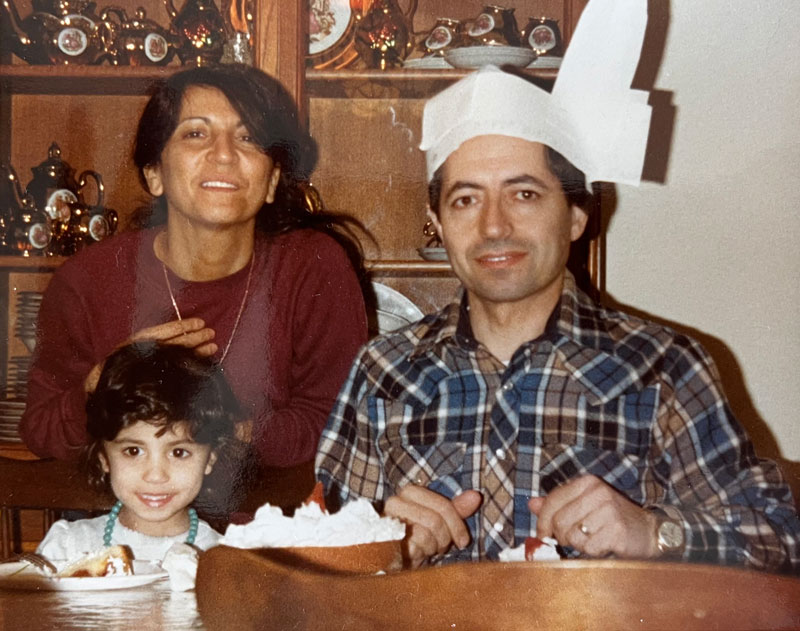How to Read Wordless Picture Books with Children
Tips for engaging young kids with these works, which can build visual literacy and foster social-emotional skills, plus a video demonstration.
 |
The author (lower left) with her parents |
Related Articles |
Someone asked me: “What is your earliest memory of being read to?”
I waited and waited, but no memory came.
Like many first-generation children born in the United States, I learned English not from my mother but alongside her. My parents brought few belongings with them from Iran, and our home had no children’s books in Farsi, our family’s mother tongue.
When a memory did come, it was of illustrations from board books in our house—one of the English alphabet and another of children’s rhymes. I loved the pictures and would trace them with pencil and lined paper.
I think my strong connection to visual literacy comes from these early experiences immersing myself in books visually, before I could read. I’ve spent my career as an art therapist, museum educator, and now, student of library science.
I discovered the possibilities of wordless picture books as an adult when I encountered Suzy Lee’s Mirror (Seven Footer, 2010), about a girl who dances with her reflection. The endpapers’ inkblot-style mirror print drew me in, and the white space of each page focused my eyes on a child whose expressions and gestures spoke so loudly. I imagined how wordless picture books could have helped my mother read to me or tell her stories alongside my own.
In a 2021 lecture, three-time Caldecott winner David Wiesner described seeing artists’ books while a student at the Rhode Island School of Design. “I wanted to make books and I wanted them to be wordless,” he knew then.
Wiesner’s “radical” decision feels apt when considering how a wordless book can disrupt power dynamics, elicit empathy, and nurture co-creation. When an adult and child take in these works, they consider together what they see and what might be happening. The hierarchy of one reader and one listener is gone. The path to the story’s telling is sensory and moves with the eye.
SEL connections
Wordless books can feel liberating, a space where the reader is an active participant in storytelling. It can also feel challenging, with confusion and vulnerability: What is happening?
The abilities developed while reading these works overlap with social-emotional learning (SEL), which supports the development of healthy self-identities and relationships. Entering characters’ worlds in a story builds empathy. Attending to facial expressions and postures teaches visual cues for emotions and encourages curiosity about what a figure is thinking or feeling. Listening to someone with a different idea of the story teaches how to sit with uncertainty and the ambiguities of what is right and wrong.
I come from oral storytellers. My parents’ generation in Iran was the first in our family to be fluent readers and writers. When I was young, my grandfather would tell us stories when we gathered for a meal. He began with Yeki bood, yeki nabood, which translates to “Once there was, once there was not.” This signaled that a story could hold room for contradiction and change.
When I open a wordless picture book, I feel connected to the tradition of oral storytelling. Reading these works with a group of children, I approach each page as I do an artwork when I teach in museums, exploring all details, including the casewrap and endpapers. I pull from museum education practices like visual thinking strategies that allow for open exploration of visual information and encouragement to root what you share in what you see.
I begin with questions: “What do you see?” Or “What’s happening here?” Then, like my work as an art therapist, I hold space for children to share what they see and how they see it, without judgment. The process of close looking unfolds and takes different paths as we co-create meaning from our individual perspectives. There is room for everyone’s story.
Hanna Salim, a mother of two in Queens, NY, has this tip for first-time readers of wordless picture books: “Use your imagination and decide for yourself which part of the story to focus on.” While reading Jerry Pinkney’s Caldecott-winning The Lion & the Mouse with her toddler son, Zaid, “it made me conscious if I was interpreting it right,” she says. “I had to come up with my own lines every time.” Salim was drawn to the book’s theme of family and its reminders that every life is connected to many others. When she read another version of this fable, though, she didn’t find that theme in the words.
I asked my seven-year-old son, Forest, about his earliest memory of being read to. He paused. “I don’t know, I guess Baby’s First Book?” I smiled and wondered what he will remember when he is an adult, and if his answer will be different in the future.
More strategies from the pros
|
Sarah Pousty is a licensed art therapist, museum educator, and MLS student in Queens, NY.
RELATED
The job outlook in 2030: Librarians will be in demand
The job outlook in 2030: Librarians will be in demand
ALREADY A SUBSCRIBER? LOG IN
We are currently offering this content for free. Sign up now to activate your personal profile, where you can save articles for future viewing






Add Comment :-
Be the first reader to comment.
Comment Policy:
Comment should not be empty !!!